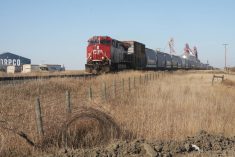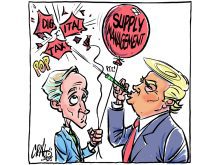With the hype caused by the scandal at Hockey Canada, few noticed earlier this month that Ottawa decided to investigate food prices and the alleged abuse by large grocery chains. The House of Commons agriculture committee will examine the problem in the coming weeks.
We must first welcome Ottawa’s decision. Even though Canada currently has the third lowest food inflation rate among the G7 countries, after Japan and France, the rate of food inflation in Canada has exceeded general inflation for 13 consecutive months.
But to investigate solely retail would be short-sighted and the committee seems to recognize that. The study will look at the entire food supply chain.
Read Also

Agriculture needs to prepare for government spending cuts
As government makes necessary cuts to spending, what can be reduced or restructured in the budgets for agriculture?
Food distribution is complex and involves several companies at once, from farm to table. Many accuse grocers such as Metro, Loblaws, and Sobeys of abusing the system and unjustifiably inflating prices. But based on publicly available data, this is far from the case.
A simple evaluation comparing the profit margins of the three major retailers, Loblaws, Sobeys and Metro, for the last five years shows that their financial results are relatively modest. Thus, at the end of their respective fiscal years in 2021, profit margins for these retailers were 3.7 percent for Loblaws, 2.7 percent for Empire-Sobeys and 4.5 percent for Metro. Returns were about the same for the last five financial years. Yields were usually below or at the same level as the rate of food inflation for most of the five years. In other words, the performances of these chains were flat when compared to the increase in the cost of living. And the year 2022, so far, doesn’t seem all that different.
Despite this, perceptions persist. Almost 80 percent of Canadians claim that there is abuse in the system, and they are not entirely wrong. The industry has disappointed in recent years, especially with the stories of grocers fixing bread prices. The current accusations, although without any real basis, are fully deserved.
Since the scope of Ottawa’s investigation will include the entire chain, from production to retail, as well as wages, this won’t be easy. Expectations remain realistically low for the committee to uncover anything at all. The food industry is filled with family businesses and companies that guard competitive data with extreme caution. Some companies buy and sell products without ever seeing or touching food. Getting to that data will be challenging.
But the committee needs to go beyond the grocer-gouging rhetoric. If there is abuse, it may be upstream in the chain. Part of the inflation of prices is objectively explained by certain macroeconomic factors, such as the shaky supply chains due to the pandemic, the labour shortages in the sector, and the invasion of Ukraine. But some portions of the price increases we see at the grocery store are hard to explain, especially at the meat counter, in the dairy section, and the fish and seafood section. There are also price hikes in the bakery aisle.
In short, the parliamentary committee must maintain a sober and virtuous logic without falling into the imaginary and the superlative. Selling a product at an exorbitant price does not necessarily constitute a scam if consumers have a choice and companies do not attempt to control market conditions. Rising costs are not the only factor contributing to price increases, either.
Fluctuations in price and demand are also important elements in food distribution. Competition and markets will influence price. This is something the committee also needs to look at.
Sylvain Charlebois is senior director of the agri-food analytics lab and a professor in food distribution and policy at Dalhousie University.

















